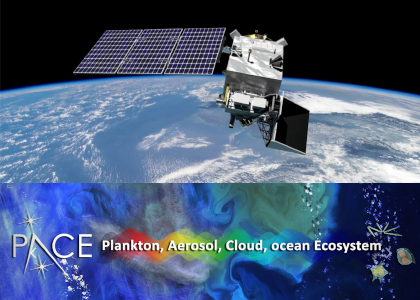The PACE mission, a hyper-spectral mission spanning from the UV to the NIR, is preparing for launch in 2023 and in anticipation we would like to develop radiative products that will be most useful for the community. To guide this effort, we are asking potential PACE data users to provide input on what products of the list below (or others) they would like to see produced from PACE, as the choice of products that will be considered for production will depend on the level of interest with the user community, in addition to considerations such as the degree to which achievable accuracy compares to needed accuracy, the feasibility of implementation, computational requirements, and the availability of data production and distribution resources.
This survey is the brainchild of Emmanuel Boss and Robert Frouin who are members of the PACE Science and Application Team and are funded to work with NASA’s OBPG on these products. We will wrap up this survey and share the results at the end of November, 2020.
Some background
In 2015 the Plymouth Marine Laboratory (PML) requested feedback from the community on the adequacy of available product including importance, usage and accuracy and additional features users felt were needed. 63 members of the community responded and their replies are compiled in Frouin et al., 2018 (doi: 10.3389/fmars.2018.00003).
Based on this survey and additional considerations a list of new products was compiled:
• Sub-surface planar and scalar PAR (as opposed to above the surface).
• Fraction of PAR absorbed by phytoplankton (APAR).
• Diffuse fraction of total irradiance (average cosine of light field just below the surface).
• Spectral planar and scalar irradiance.
• Spectral diffuse attenuation coefficient for downward irradiance,
• Surface albedo (ratio of planar upward irradiance to downward planar irradiance just above the ocean surface).
• UV-A, UV-B planar and scalar irradiance (with photon and energy units).
• Products without gaps (in space/time) to provide boundary conditions to models.
• Upper-ocean heating profile.
• Diurnal distribution of PAR and its attenuation.
• Averaged mixed-layer PAR.
• Under-ice light fields.
Current products that are likely to be available for PACE
NASA’s Ocean Biology Processing Group (OBPG) currently produces the following products associated with radiometry, from a host of active and legacy multispectral satellite sensors (based on https://oceancolor.gsfc.nasa.gov/product_status/):
Rrs – Water leaving radiance normalized by surface irradiance calculated as TOA irradiance scaled by atmospheric transmittance and solar geometry and corrected for BRDF effects and changes in earth-sun distance. Unit – [sr-1]
PAR – Daily average downward planar photosynthetically available radiation above surface. Unit – [Einstein m-2 day-1]
iPAR – Instantaneous clear sky downward planar photosynthetically available radiation just above surface at the time of satellite passage. Unit – [Einstein m-2 s-1]
Kd490 – Diffuse attenuation coefficient of downwelling planar irradiance at 490nm. Unit – [m-1]
Euphotic depth – Euphotic depth (defined as the depth of the 1% planar PAR irradiance depth relative to its surface value (0-). Unit – [m]





